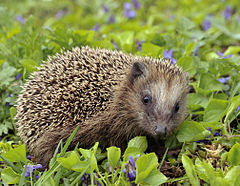Owadożery (ssaki)
rząd ssaków
Owadożery[22] (Eulipotyphla) – rząd ssaków z podgromady ssaków żyworodnych (Theria).
| Eulipotyphla | |||||
| Waddell, Okada & Hasegawa, 1999[1] | |||||
 Przedstawiciel rzędu – jeż zachodni (Erinaceus europaeus) | |||||
| Systematyka | |||||
| Domena | |||||
|---|---|---|---|---|---|
| Królestwo | |||||
| Typ | |||||
| Podtyp | |||||
| Gromada | |||||
| Podgromada | |||||
| Magnordo | |||||
| Nadrząd | |||||
| Rząd |
owadożery | ||||
| |||||
| Podrzędy | |||||
| |||||
Zasięg występowania
edytujRząd obejmuje gatunki występujące w Ameryce, Eurazji i Afryce[23].
Podział systematyczny
edytujPodział na Soricomorpha i Erinaceomorpha jest parafiletyczny, więc żeby zachować monofiletyzm grupy zaproponowano nową nazwę Eulipotyphla[23]. Do rzędu należą następujące występujące podrzędy[24][25][26]:
- Erinaceota Van Valen, 1967
- Solenodonota Brace, J.A. Thomas, Dalén, Burger, MacPhee, Barnes & Turvey, 2016
Opisano również rodziny wymarłe nie sklasyfikowane w żadnym z powyższych podrzędów[27]:
- Geolabididae McKenna, 1960
- Micropternodontidae Stirton & Rensberger, 1964
- Vastaniidae Bajpai, Kapur, Das, Tiwari, Saravanan & Sharma, 2005
Rodzaje wymarłe o niepewnej pozycji systematycznej i nie sklasyfikowane w żadnym z powyższych podrzędów:
- Quadratodon De Bast & T. Smith, 2016[28] – jedynym przedstawicielem był Quadratodon sigei De Bast & T. Smith, 2016
Przypisy
edytuj- ↑ P.J. Waddell, N. Okada & M. Hasegawa. Towards Resolving the Interordinal Relationships of Placental Mammals. „Systematic Biology”. 48 (1), s. 1–5, 1999. DOI: 10.1093/sysbio/48.1.1. (ang.).
- ↑ J.H.F. Link: Beyträge zur Naturgeschichte. Zweytes Stück. Ueber die Lebenskräfte in naturhistorischer Rücksich, und die Classification der Säugethiere. Rostock: K.C. Stiller, 1795, s. 52. (niem.).
- ↑ C.K. André: Der Zoologe, oder Compendiöse Bibliothek des Wissenswürdigsten aus der Thiergeschichte und allgemeinen Naturkunde. Cz. Heft V–VIII. Eisenach: Johann Jacob Gebauer, 1797, s. 28. (niem.).
- ↑ J.K.W. Illiger: Prodromus systematis mammalium et avium: additis terminis zoographicis utriusque classis, eorumque versione germanica. Berolini: Sumptibus C. Salfeld, 1811, s. 123. (łac.).
- ↑ G. Cuvier: Le règne animal distribué d’après son organisation, pour servir de base a l’histoire naturelle des animaux et d’introduction a l’anatomie comparée. T. 1. Paris: Chez Déterville, s. 131. (fr.).
- ↑ T.E. Bowdich: An analysis of the natural classifications of Mammalia, for the use of students and travellers. Paris: J. Smith, 1821, s. 24, 31. (ang.).
- ↑ J.G. Wagler: Natürliches System der Amphibien, mit vorangehender Classification der Säugethiere und Vögel. Ein Beitrag zur vergleichenden Zoologie. München, Stuttgart und Tübingen: In der J.G. Cotta’scchen Buchhandlung, 1830, s. 14. (niem.).
- ↑ A.N. Pomel. Études sur les carnassiers insectivores (Extrait). Première partie.—Insectivores fossiles. „Archives des sciences physiques et naturelles”. 9, s. 246, 1848. (fr.).
- ↑ E. Haeckel: Generelle morphologie der organismen. Allgemeine grundzüge der organischen formen-wissenschaft, mechanisch begründet durch die von Charles Darwin reformirte descendenztheorie. Cz. 2. Berlin: G. Reimer, 1866, s. clx. (niem.).
- ↑ T.N. Gill. On the characteristics of the primary groups of the class of mammals. „The American naturalist”. 5 (8–9), s. 532, 1871. (ang.).
- ↑ T.N. Gill: Order III. – Insectivora. W: J.S. Kingsley: The Standard Natural History. Cz. 5: Mammals. Boston: S.E. Cassino, 1884, s. 136. (ang.).
- ↑ Gregory 1910 ↓, s. 464.
- ↑ Gregory 1910 ↓, s. 465.
- ↑ R. Saban. Phylogénie des insectivores. „Bulletin du Muséum national d’histoire naturelle”. 2e série. 26 (3), s. 429, 1954. (fr.).
- ↑ H. Heim de Balsac & F. Bourlière: Ordre des insectivores. Systématique. W: P.-P. Grassé (red.): Traité de Zoologie: Anatomie, Systématique, Biologie. Cz. 17: Mammifères. Les Ordres: Anatomie, Éthologie, Systématique. Paris: Masson & Cie, 1955, s. 1656. (fr.).
- ↑ M.J. Novacek. The Sespedectinae, a new subfamily of hedgehog-like insectivores. „American Museum novitates”. 2822, s. 23, 1985. (ang.).
- ↑ Kalandadze i Rautian 1992 ↓, s. 54.
- ↑ Kalandadze i Rautian 1992 ↓, s. 55.
- ↑ K.E. Kinman: The Kinman System: Toward a Stable Cladisto−Eclectin. Classification of Organisms (Living and Extinct). Kansas, Hays: K.E. Kinman, 1994, s. 37. (ang.).
- ↑ S.L. Walsh. Notes on the anterior dentition and skull of Proterixoides (Mammalia: Insectivora: Dormaaliidae), and a new dormaaliid genus from the early Uintan (Middle Eocene) of Southern California. „Proceedings of the San Diego Society of Natural History”. 34, s. 3, 1998. (ang.).
- ↑ a b c І.В. Загороднюк. Наукові назви рядів ссавців: від описових до уніфікованих. „Вісник Львів. Ун-ту”. Серія біологічна. 48, s. 36, 2008. (ukr.).
- ↑ C. Błaszak (red.): Zoologia. Ssaki. T. 3. Cz. 3. Warszawa: PWN, s. 23, 45, 61, 190–235. (pol.).
- ↑ a b C.J. Burgin, D.E. Wilson, R.A. Mittermeier, A.B. Rylands, T.E. Lacher & W. Sechrest: Illustrated Checklist of the Mammals of the World. Cz. 2: Eulipotyphla to Carnivora. Barcelona: Lynx Edicions, 2020, s. 20–86. ISBN 978-84-16728-35-0. (ang.).
- ↑ N. Upham, C. Burgin, J. Widness, M. Becker, C. Parker, S. Liphardt, I. Rochon & D. Huckaby: Treeview of Mammalian Taxonomy Hierarchy. [w:] ASM Mammal Diversity Database (Version 1.11) [on-line]. American Society of Mammalogists. [dostęp 2023-10-22]. (ang.).
- ↑ C.J. Burgin: Introduction. W: Lynx Nature Books: All the Mammals of the World. Barcelona: Lynx Edicions, 2023, s. 26. ISBN 978-84-16728-66-4. (ang.).
- ↑ Nazwy zwyczajowe za: W. Cichocki, A. Ważna, J. Cichocki, E. Rajska-Jurgiel, A. Jasiński & W. Bogdanowicz: Polskie nazewnictwo ssaków świata. Warszawa: Muzeum i Instytut Zoologii PAN, 2015, s. 61–77. ISBN 978-83-88147-15-9. (pol. • ang.).
- ↑ J.S. Zijlstra, Eulipotyphla Waddell, Okada & Hasegawa, 1999, Hesperomys project (Version 23.8.1), DOI: 10.5281/zenodo.7654755 [dostęp 2023-10-22] (ang.).
- ↑ E. De Bast & T. Smith. The oldest Cenozoic mammal fauna of Europe: implication of the Hainin reference fauna for mammalian evolution and dispersals during the Paleocene. „Journal of Systematic Palaeontology”. 15 (9), s. 759, 2016. DOI: 10.1080/14772019.2016.1237582. (ang.).
Bibliografia
edytuj- W.K. Gregory. The orders of mammals. „Bulletin of the American Museum of Natural History”. 27, s. 1–524, 1910. (ang.).
- H.Н. Каландадзе & А.С. Раутиан: Система млекопитающих и историческая зоогеография. W: Филогенетика млекопитающих. Москва: Издательство Московского университета, 1992, s. 44–152. (ros.).
Identyfikatory zewnętrzne: